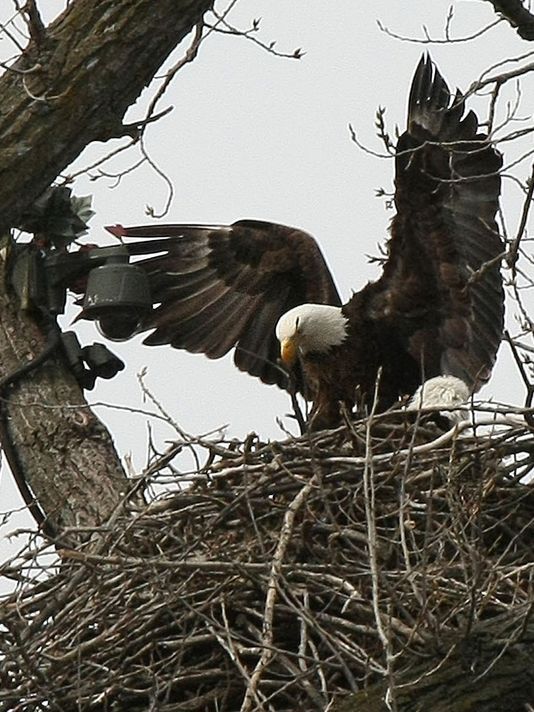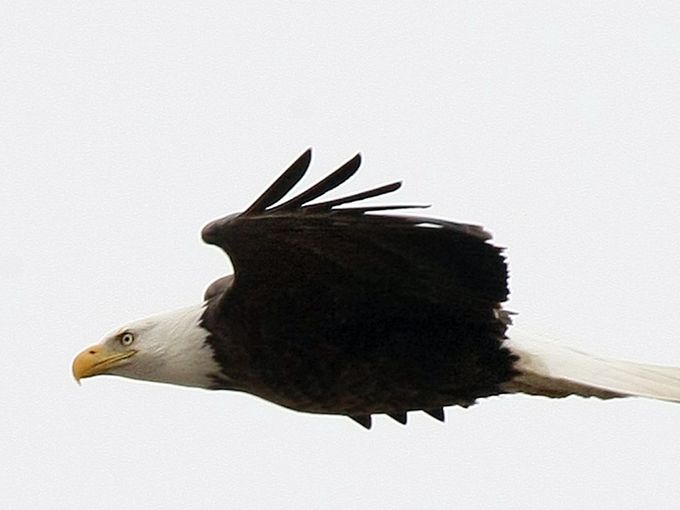
Nearly 3,800 comments of sadness and outrage flooded the Raptor Resource Project's Facebook page in the next 24 hours. One woman posted that she was so heartbroken she took to the piano to play "Wind Beneath My Wings," which she also played at her mother's funeral.
"People loved this bird," said Bob Anderson, the raptor researcher from Decorah, Iowa who made the Decorah eagles world-famous by first mounting a nest camera in 2008. "I'm trying to keep people calm."
Some questioned what can be done about the bird-zapping problem of electrical lines that has occurred since the first telegraph pole was erected in the mid-19th century.
Power poles are attractive to raptors as high perching spots, and eagles are the most commonly electrocuted birds - 4,300 between 1960 and 1995, according to a federal study cited in a 2005 report by biologist Albert Manville. Electrocution was the fourth-leading cause of death among bald eagles, behind accidental trauma, poisoning and shooting.
On Tuesday morning, the male eagle that was hatched this spring was seen soaring over the bluff near a city compost site that the young eagles had frequented since leaving the nest.
"We were all impressed by his flying skill," said Anderson of the eagle he called EWOT (eagle without transmitter) and eagle fans called Indy.
Indy appeared to be the sensible one of three hatched this year. Another eaglet had to be repeatedly rescued after fledging, and the third broke its wing and is recovering after surgery at a bird rescue facility in Carroll County.
But Anderson suspects the young eagle was returning to the compost site and attempted to land on the power pole, which is a half mile from the compost site. He was later found at the base of the pole with singed feathers on both legs and a hole in one wing.
"Either (the current) went in the wing and out the feet or vice versa," Anderson said.

The single-pole structure in Decorah carried 69,000 volts and was not retrofitted with "avian-safe technology," said Tom Petersen, communications director of ITC Midwest in Cedar Rapids, which owns the line. He describes the technology, used on some of the company's other lines, as "making lines more visible so birds don't fly into them."
"We have not had instances where there was contact with eagles before," he said. "Once we heard about this instance, we contacted U.S. Fish and Wildlife so we can look at our options to prevent this in the future. We've all watched these eagles, and it is very sad this happened."
Officials at MidAmerican Energy in Des Moines, Iowa said the company conducts environmental studies, which take into consideration the migratory routes and potential nesting habitat of birds, and chooses equipment sites with minimal avian use to avoid bird accidents. It also implemented a voluntary avian protection plan in 2012 that prioritized parts of its system to be retrofitted with avian-safe technology. The changes include reflective tags attached to power lines to help prevent collisions, bird guards to deter large birds from perching on poles or wires, and insulator covers to prevent electrical contacts on distribution lines.
Anderson doesn't blame the electric companies. Although he says it's rare to find an eagle killed by high-voltage transmission lines, he does pick up roughly one eagle a year killed by lower-voltage lines. Two eagles from the Decorah nest were electrocuted in 2012.
"No one wants to kill an eagle," he said. "They are such huge birds with such huge wings that weird things happen. One bird was carrying a fish that touched a line and it was electrocuted."
The lone eaglet remaining in Decorah, Iowa is said to be doing well, although it will now have to sit by itself on the compost pile to await feedings from the parents. It's been about as rough for the eagle followers.
"I'm sitting here bawling as I read this sad news to my husband," wrote a woman from Kentucky on Facebook.
Source: The Des Moines Register



Oups!